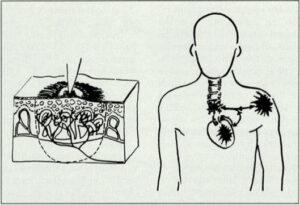The benefits of Osteopathic treatment
The pain relief benefits of Osteopathic treatment have been known & talked about for a long time. This is not just amongst Osteopaths & their patients, but other healthcare professionals such as Doctors, nurses & midwives. There is even evidence for this with “96.4% of patients being ‘satisfied or very satisfied’ with osteopathic care”.
It’s generally said that we tend to help with low back pain, neck pain, shoulder pain & sciatic pain. This is very true & the evidence is mounting for this, however, it is only part of the story.
When you start to look closer at what we do, the effects of treatment are far wider ranging. The benefits to you are likely to be greater than the original complaint you came to us for help with. Let’s consider how getting pain relief might affect your life. These are ‘real life benefits’ of Osteopathic treatment. Then let’s look at the evidence for how Osteopathy can provide pain relief.
Real life benefits of Osteopathic treatment:
| Task you want to achieve | Healthy Choice Options To Help You Achieve Your Goal |
|---|---|
| Enjoy the simple act of walking by myself/with my partner/my dog | Try doing some stretches as directed and use a hot & cold compress – also, try Osteopathy |
| Improve my ability to relax | Try Osteopathy as it has been shown to help people to relax |
| Have less headaches | Try Osteopathy as it has been shown to help people with their headaches |
| Play golf / football / rugby / cricket without pain. Ride my bike without pain Go for a run without pain Work without pain Enjoy the garden without pain Pick up my children without pain | For all of these things, try doing some stretches as directed by your Osteopath, (or Acupuncturist / Craniosacral Therapist), or (as directed by your therapist), use a hot and cold compress, strapping / support bandages or garments, certain strength training may also help as due to our sedentary lifestyles we often have muscles tighter in one area of the body compared to another. Lastly, but definitely not least, try Osteopathy, it works. As mentioned earlier, research says that “96.4% of patients were ‘satisfied or very satisfied’ with osteopathic care”. |
Unsure of Osteopathy is for you?

There are many reasons for needing help with health and mobility. If you’re in doubt as to whether or not we can help then please feel free to contact us. A quick chat won’t cost you a penny and could change life as you know it.
Call us on 07984007459 or email us. If you’ve decided already then head over to our bookings page and book online.
Still unsure about Osteopathy? – then keep reading.
Clinical Evidence for Osteopathy
The focus of more recent clinical research has largely been around low back pain, neck pain and headaches. The benefits as well as the risks of Osteopathic treatment are then highlighted. This is reflected in the list of benefits that an Osteopath is allowed to advertise. See below for what the Advertising Standards Agency (ASA) have to say about this.
So according to the ASA, which medical conditions can osteopaths claim to treat?
This table is based on evidence submitted to the Committee of Advertising Practice (CAP) prior to November 2016. The ASA and CAP accept that Osteopaths can claim to treat the following:
| Neck pain*1 |
| Arthritic pain |
| Low Back Pain (Lumbago) |
| Generalised aches & pains / Joint pains |
| Muscle spasms / Cramp |
| Shoulder pain, frozen shoulder / elbow pain / tennis elbow (lateral epicondylitis) arising from associated musculoskeletal conditions of the back and neck, but not isolated occurrences |
| Sciatica |
| Rheumatic pain |
| Joint pains including hip & knee pain from osteoarthritis as an adjunct to core OA treatments & exercise |
| General, acute & chronic backache, back pain (not arising from injury or accident) |
| Minor sports injuries |
| Headache arising from the neck (cervicogenic) / Migraine prevention |
| Neuralgia |
| Tension & inability to relax |
| Circulatory problems |
| Digestion problems |
| Fibromyalgia |
| *1 not including pain following injury i.e. whiplash which involves the tearing of ligament & muscle tendon tissues & is not curable using Osteopathy – although Osteopathic treatment applied to other areas of the body may help reduce the strain placed on the patient’s neck muscles & ligaments, so promoting healing. |
High level of patient satisfaction
A 2013 study which was referenced in a British Medical Journal (BMJ) article. This was called ‘Promising evidence that osteopathy may relieve musculoskeletal pain’. “There’s promising evidence that osteopathy, the physical manipulation of the body’s tissues & bones, may relieve the pain associated with musculoskeletal conditions“. This provided a review of the available clinical evidence & is published in the open access journal BMJ Open.
The key messages from the article are:
This summary of osteopathic research should be treated as a very basic snapshot of past & current activity:
- Osteopathy is delivered in a variety of settings (various private practices in varying locations)
- Patients report high satisfaction with treatment
- There is good quality evidence supporting the beneficial effects of manipulation for back pain
- The government recommends osteopathy for sub-acute & chronic low back pain
- The risk of experiencing serious adverse reaction to osteopathic treatment is very small; reports of serious adverse events are rare.
- Around half of patients may experience mild, short-lived, self-resolving treatment reactions, which usually amount to some stiffness around the area of manipulation which resolves within 24 – 48hrs, but overall leaving you feeling much improved compared to before treatment.
Further information concerning osteopathic research can be found on our ‘research evidence’ page. You can also read our own articles about headaches & neck pain amongst others on the ‘pain relief’ section of our website.
Other considerations with Osteopathic Treatment
Richard L. Van Buskirk (an American Osteopathic Doctor) wrote a paper in 1990. In it, he showed that if there is restriction in mobility in the musculoskeletal system (joints & muscles) then there is a corresponding nerve signal that travels from the muscles & joints to the spinal cord & back on to the joints & muscles again which maintains the problem unless correction is applied to the aforementioned joints & muscles.
He also found that the nerve signal passed not just back to the joints & muscles, but that it could also be sent to the body’s organs & connective tissues, thus affecting their function too. It should be remembered that this includes the immune system, our means of fighting off disease. (paraphrased for simplicity).
It is for this reason that Osteopathy should not be thought of as just a means of loosening up your joints & relieving back, neck or shoulder pain (or pain in any other joint for that matter), but it should also be borne in mind that Osteopathy has the potential to help reduce high levels of inflammation that have been shown to lead to disease, which includes “cardiovascular disease, diabetes, autoimmune conditions & even clinical depression”.
For your own personal interest in the subject, an excerpt from Van Buskirk’s article is shown at the end of this article *2
So is Van Buskirk & his older research still considered relevant?
There is limited research available on the subject so it is difficult to say for sure. The ASA and GOsC (the governing body for Osteopathy in the U.K.) say it’s less likely, but that’s due to a lack of multiple pieces of “robust” evidence. Yet, the advertising standards authority (ASA) suggest that Osteopaths can claim to treat circulatory problems, digestion problems & Fibromyalgia, amongst the many pain related conditions.
Interesting to see such opposing views relating to the same subject matter, from these organisations, isn’t it?
Osteopathy has a little way to go to fully prove itself & its physiology-mediating capabilities, but then so has General Medicine. However, the Osteopathic principles & theories that have held strong for over 150 years have been proven correct in respect of pain relief – so why not physiology & general health? Time will provide the answer I’m sure.
Testimonials from our patients
Check our genuine reviews from Google and see what our lovely patients have to say about us.
See all our Google reviews.

Don’t forget – you can call us & talk to us about your pain related problem for free.
If we are busy with another patient, then we may ask to call you back at a more convenient time for a free 10 minute chat.
If you would like to book in to see us for either Osteopathy or Cranio-Sacral Therapy, then head over to our ONLINE BOOKING PAGE & find the time that is right for you.
Addendum
*2 An excerpt from Van Buskirk’s article is shown below:
“A model of somatic dysfunction is developed in which restriction in mobility and autonomic, visceral, and immunologic changes are produced by pain related sensory neurons and their reflexes. Nociceptors are known to produce muscular guarding reactions, as well as autonomic activation, when musculoskeletal or visceral tissue is stressed or damaged.
This guarding causes abnormal musculoskeletal position and range of motion. Local inflammatory responses and autonomic reflexes further reinforce nociceptor activity, maintaining restriction. Nociceptive autonomic reflexes also evoke changes in visceral and immunologic function.
Finally, maintenance of muscles, joints, and related tissues in an abnormal guarding position causes changes in the connective tissues, solidifying the abnormal position. Stretching these tissues into a normal range of motion will restimulate the nociceptor, reflexly reinforcing the somatic dysfunction. This model has evolved from Korr’s neurologic model but emphasises the nociceptor and its reflexes as a source of the connective tissue, circulatory, visceral, and immunologic changes seen in the somatic dysfunction.”
Peripheral branching of the nociceptor and its relation to the axon reflex (left) and convergence of inputs from diverse sources such as heart and shoulder (right).
The example shown here is that of a dysfunctional shoulder joint leading to an aberrant reflex signal to the heart, showing just one possible link between the joints/muscles and our internal organs.

